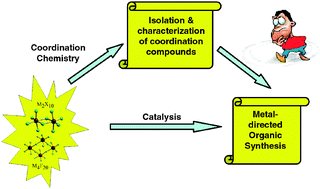The chemistry of niobium and tantalum pentahalides, MX5, with oxygen compounds is reviewed herein. The polynuclear structure of MX5 is readily broken by addition of oxygen-containing organic molecules, L, to give either mononuclear or ionic dinuclear coordination adducts. Then activation of the organic ligand may take place favoured by several factors, i.e. low M–X bond energy, high temperature, presence of more than one oxygen function within L, L/M molar ratio ≥ 2. The activation reactions are often uncommon in the context of metal halides; they include the cleavage of Csp3–O, Csp2–O, C–H and C–C bonds, and eventual successive rearrangements proceeding with C–O or C–C couplings. The recently elucidated reactivity of MX5 with limited amounts of oxygen compounds will be presented, and possible connections with the relevant MX5-directed syntheses reported in the literature will be outlined.

